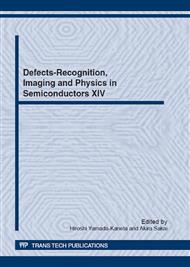p.149
p.153
p.157
p.161
p.165
p.171
p.175
p.179
p.183
Change of the Characterization Techniques as Progress of CuInSe2-Based Thin-Film PV Technology
Abstract:
In the CuInSe2(CIS)-based thin-film PV technology, various characterization techniques have been applied to measure the composition, crystal structure, depth profile and defect chemistry and so on, since Boeing Aerospace, for the first time, has come to the 10 % milestone in a thin-film form in 1980 by fabricating a very small single cell with top grids. More advanced and comprehensive characterization techniques are being applied after over 18 % total-area efficiency was consistently achieved employing the “three stage method”, which was developed by National Renewable Energy Laboratory (NREL). Comparing to the CIS-based absorber, there are not so many researches to investigate the absorber/buffer interface because the buffer is too thin to analyse separately and precisely and there are quite limited information on reaction pathways and composition of the buffer layer. However, in order to achieve the aperture-area efficiency of over 18 % on over 800cm2-sized large-area integrated circuits, it is remarkably important how to enhance the quality of absorber/buffer interface. Therefore, analytical works to understand how to improve the FF should tend to be more and more important.
Info:
Periodical:
Pages:
165-170
Citation:
Online since:
July 2012
Price:
Сopyright:
© 2012 Trans Tech Publications Ltd. All Rights Reserved
Share:
Citation:


